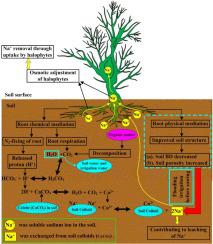当前位置:
X-MOL 学术
›
Field Crops Res.
›
论文详情
Our official English website, www.x-mol.net, welcomes your feedback! (Note: you will need to create a separate account there.)
Cotton/halophytes intercropping decreases salt accumulation and improves soil physicochemical properties and crop productivity in saline-alkali soils under mulched drip irrigation: A three-year field experiment
Field Crops Research ( IF 5.8 ) Pub Date : 2021-03-01 , DOI: 10.1016/j.fcr.2020.108027 Jiaping Liang , Wenjuan Shi
Field Crops Research ( IF 5.8 ) Pub Date : 2021-03-01 , DOI: 10.1016/j.fcr.2020.108027 Jiaping Liang , Wenjuan Shi

|
Abstract Soil salinization has become a severe threat deteriorating soil quality and restricting sustainable agricultural development in arid and semi-arid areas. The objective of this study was therefore to propose a new cotton/halophytes intercropping system [such as cotton/Suaeda salsa intercropping (CSSI) and cotton/alfalfa intercropping (CAI) systems] to improve soil salinization and crop production based on the traditional monoculture cotton (MC). A three-year field experiment was conducted to explore the effects of the MC, CSSI, and CAI systems on soil salt accumulation, salt removal, soil physicochemical properties, root mass density, aboveground biomass, seed cotton yield, and irrigation water productivity (IWP). Experiment treatments consisted of three cropping systems: MC, CSSI, and CAI systems, respectively. All treatments were designed using a randomized complete block with three replications. The result indicated that the CSSI and CAI systems could decrease soil EC1:5, salt accumulation, bulk density, Na+ content, and pH in no mulch strips and increase salt removal, soil porosity, and organic carbon content compared with the MC system. Compared with the MC system, the CSSI system increased root mass density in 0−20 cm soil depth. No significant differences in seed cotton yield and IWP were found among the MC, CSSI, and CAI systems in 2014. However, total aboveground biomass, seed cotton yield, and IWP were significantly higher in the CSSI and CAI systems than that of the MC system in 2015 and 2016. This study suggested that the cotton/halophytes intercropping system showed greater salt removal and crop productivity than the MC system. Therefore, the CSSI and CAI systems should be recommended as a long-term agronomic remediation method for improving soil salinization and increasing cotton yield in the arid area of northwest China.
中文翻译:

棉花/盐生植物间作减少盐分积累并改善盐碱地土壤理化性质和作物生产力的覆盖滴灌:三年田间试验
摘要 土壤盐渍化已成为干旱和半干旱地区土壤质量恶化、制约农业可持续发展的严重威胁。因此,本研究的目的是提出一种新的棉花/盐生植物间作系统 [如棉花/Suaeda salsa 间作 (CSSI) 和棉花/苜蓿间作 (CAI) 系统],以改善基于传统单一栽培棉花的土壤盐渍化和作物产量(MC)。进行了为期三年的田间试验,探讨了 MC、CSSI 和 CAI 系统对土壤盐分积累、脱盐、土壤理化性质、根质量密度、地上生物量、籽棉产量和灌溉水生产力(IWP)的影响。 )。试验处理由三种作物系统组成:分别是 MC、CSSI 和 CAI 系统。所有治疗均使用随机完整区组设计,重复三次。结果表明,与MC系统相比,CSSI和CAI系统可以降低无覆盖带的土壤EC1:5、盐分积累、容重、Na+含量和pH值,增加脱盐量、土壤孔隙度和有机碳含量。与 MC 系统相比,CSSI 系统增加了 0-20 cm 土壤深度的根质量密度。2014 年 MC、CSSI 和 CAI 系统之间的籽棉产量和 IWP 没有显着差异。 但是,CSSI 和 CAI 系统的总地上生物量、籽棉产量和 IWP 显着高于 MC 系统2015 年和 2016 年。这项研究表明,棉花/盐生植物间作系统比 MC 系统显示出更大的盐分去除和作物生产力。所以,
更新日期:2021-03-01
中文翻译:

棉花/盐生植物间作减少盐分积累并改善盐碱地土壤理化性质和作物生产力的覆盖滴灌:三年田间试验
摘要 土壤盐渍化已成为干旱和半干旱地区土壤质量恶化、制约农业可持续发展的严重威胁。因此,本研究的目的是提出一种新的棉花/盐生植物间作系统 [如棉花/Suaeda salsa 间作 (CSSI) 和棉花/苜蓿间作 (CAI) 系统],以改善基于传统单一栽培棉花的土壤盐渍化和作物产量(MC)。进行了为期三年的田间试验,探讨了 MC、CSSI 和 CAI 系统对土壤盐分积累、脱盐、土壤理化性质、根质量密度、地上生物量、籽棉产量和灌溉水生产力(IWP)的影响。 )。试验处理由三种作物系统组成:分别是 MC、CSSI 和 CAI 系统。所有治疗均使用随机完整区组设计,重复三次。结果表明,与MC系统相比,CSSI和CAI系统可以降低无覆盖带的土壤EC1:5、盐分积累、容重、Na+含量和pH值,增加脱盐量、土壤孔隙度和有机碳含量。与 MC 系统相比,CSSI 系统增加了 0-20 cm 土壤深度的根质量密度。2014 年 MC、CSSI 和 CAI 系统之间的籽棉产量和 IWP 没有显着差异。 但是,CSSI 和 CAI 系统的总地上生物量、籽棉产量和 IWP 显着高于 MC 系统2015 年和 2016 年。这项研究表明,棉花/盐生植物间作系统比 MC 系统显示出更大的盐分去除和作物生产力。所以,



























 京公网安备 11010802027423号
京公网安备 11010802027423号